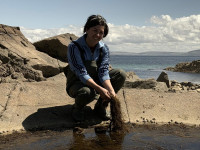Marine Biodiversity
Post-Doctoral Fellowships
Ireland
Invasive seaweeds: can commercial harvesting be a win-win solution?
Invasive species of seaweed, intentionally or accidentally introduced into new habitats, can disrupt the local marine ecosystem, gravely endangering the biodiversity, and by association, the local economy. At the same time, these invasive organisms are known to produce a plethora of bioactive compounds with multiple commercial applications in the food, pharmaceutical and cosmetics sectors. Hence, their harvesting/removal and utilization by industry has been frequently proposed as a win-win solution, especially since market opportunities are currently hindered by the limited availability of exploitable biomass. But for any such initiative to safely take shape, crucial unanswered questions first need to be considered. For example, should we expect detrimental environmental impacts from the physical removal of this biomass? Is there a risk it will throw an already weakened ecosystem into further imbalance? Is the biomass itself suitable for industrial exploitation? “A careful, balanced evaluation of the pros and cons is highly needed, including the assessment of the negative effects on biodiversity, the socio-economic challenges and the biotechnological potential”, explains Dr. Marianela Zanolla, a researcher in seaweed biology at the Botany and Plant Science Department of the National University of Ireland Galway. She is leading a project that aims to assess the valorization potential of invasive seaweeds in Ireland, as well as the harvesting impact or alternatively, inland cultures, to either guide or discourage future exploitation. The long-term objective is also to provide governmental and non-governmental agencies with guidance and support on how to manage invasive species in Ireland.
“The idea behind the project is to take a close look at whether we can transform this detrimental invasion into something positive for local communities”, summarizes Dr. Zanolla. The project’s objective is set in the context of the Blue Bioeconomy, in other words, it seeks to contribute to the creation of sustainable businesses that are based on renewable marine resources. “The commercial utilization of non-native, invasive species is a controversial topic”, she reports, “and for good reasons. Before we act on this seemingly ideal solution, we need to make sure it will not further damage the local ecosystem. For instance, the process of harvesting could, in itself, increase the dispersal of the seaweed, or further deteriorate the habitat”. In addition to environmental concerns, her project seeks to assess the economic viability of such a solution. “For the biomass to be exploitable by industries, it needs to be abundant enough, and stable enough”. As she explains: “Algae are living organisms, they respond to their surroundings, so when they grow in the natural environment, major variabilities in composition can be found within the same species. If the biomass supply is not sufficient, or too unstable in composition, commercialization becomes impossible”. For that reason, the project also aims to look at the possibility of land-based culture. “If we find that sea harvesting is too risky or inappropriate, pond culture could be a safer and more reliable alternative. We wouldn’t have a double win, but our primary goal is not to set the island free of invasive seaweeds, it would only be a happy consequence of our research”, Dr. Zanolla says.
Assessing the valorization potential of four highly-invasive species of algae
Specifically, the project looks into the potential valorization of four notoriously invasive macroalgal species found on the Irish west coast, “two brown, one red and one green”, she explains, or more precisely: Sargassum muticum and Colpomenia peregrina (both Phaeophyceae), Asparagopsis armata (Rhodophyta), and Codium fragile ssp. tomentosoides (Chlorophyta). “We cannot look at all the invasive species present in Ireland, because we would need a lot more than 2 years, so we’ve carefully chosen the ones that, in addition to having a high impact on native ecosystems, have a high economic potential due to interesting chemical composition”. The project will pursue three consecutive objectives: investigate the distribution and abundance of the selected species and evaluate the threat they pose to marine Irish ecosystems; analyze their high value applications, as well as stability and consistency of profiles, by means of chemical profiling; and finally, assess the potential for valorization of all four species, either through harvesting of natural populations or land-based cultivation. In addition, the first work package will include “citizen science” initiatives. In other words, the research team will also turn to the community for insights on the algae’s distribution across space and time. “In west Ireland, most of the income comes from fishing. Local communities are on the front line of the algae problem. They have a knowledge of the area that I could never have, so that’s invaluable information for our team. If we only looked at scientific papers, imagine how much we would miss!”.
Biological invasions are the second major cause of species endangerment and extinction worldwide. “Prevention is the best way to avoid non-native seaweed invasion, but now that some species have established themselves, we don’t have a choice but to look for management solutions as well”, says Dr. Zanolla. This project falls into the latter category but does not pursue solely environmental purposes. Its innovative nature lies into its integrated approach, one that seeks to unify social, economic and ecological objectives. In this sense, the output is likely to provide both the public and private sectors with applicable, realistic, multi-faceted solutions to build a more sustainable future.

Marianela
ZANOLLA
Institution
National University of Ireland
Country
Ireland
Nationality
Spanish
Related articles
Marine Biodiversity
Climate Change
Post-Doctoral Fellowship
Spain
Climate-Smart Strategies to Develop Resilience in Artisanal Fisheries of Mediterranean Marine Protected Areas
Determining the climate risk exposure of marine ecosystems is crucial to develop strategies that will strengthen communities’ resilience. Studies have... Read more

Marina
SANZ MARTíN
Spanish Institute of Oceanography
Marine Biodiversity
Food & Nutrition
Post-Doctoral Fellowship
United Kingdom
Integrating Aquaculture and Capture Fisheries to Combat Hunger in Sierra Leone and Other Parts of Africa
During her AXA Research Fund fellowship at the University of Leeds, Dr. Nwamaka Okeke-Ogbuafor will seek to unlock ocean-based solutions... Read more

Nwamaka
OKEKE OGBUAFOR
University of Leeds
Extreme Weather Events
Marine Biodiversity
Climate Change
AXA Chair
United States
Building Resilience to Coastal Hazards with Natural Defenses
The results that Professor Michael Beck, from the University of California, Santa Cruz (UCSC), has already achieved in this groundbreaking... Read more

Michael
BECK